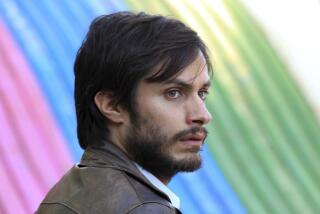BOOK REVIEW : Tales of a Life Spent in Harm’s Way : UNREASONABLE BEHAVIOR. <i> By Don McCullin</i> , <i> with Lewis Chester</i> . Knopf. $24; 304 pages
It’s tempting to regard the combat photographer as a kind of knight errant of the 20th Century, a relentless ghost of conscience who haunts the battlefields of the world.
And Don McCullin, who tells his life story in “Unreasonable Behavior,” displays all the right qualities to play the role: He is clear-eyed but compassionate, battle-hardened but morally alert, genuinely courageous under fire but never gung-ho.
“He’s a Scotsman called McCullin,” a comrade once said of McCullin’s taste for working on the front line, “and just too mean to buy a Telephoto lens, that’s all.”
But McCullin himself mostly refuses to strike a pose, and his autobiography--like his gritty black-and-white war photography--is dark, brooding and insistently honest. Truth rather than glory is what attracts his eye.
“Looking at what others cannot bear to see is what my life as a war reporter is all about,” he writes. “You sleep with the dead, you cradle the dead, you live with the living who became the dead.”
McCullin, a child of the Blitz, grew up poor and tough on some of the meaner streets of London: “I was born in the ‘30s,” he writes, “and bombed in the ‘40s.” Attired in “brother-creepers” and “a Teddy Boy suit,” he hung out with bikers and street gangs, and later served a stint in the air force, where he picked up a camera almost by accident.
A few photographs of the Berlin Wall under construction landed McCullin his first regular work as a photographer, and he soon found himself under fire in Cyprus, where Greeks and Turks were engaged in house-to-house fighting.
“It was a kind of madness,” he recalls. “The battle lasted all day, and I felt I had lived a lifetime.”
In fact, McCullin was just embarking on a lifetime in harm’s way. He has photographed men and woman at war in Biafra and the Congo, Beirut and Belfast, Afghanistan and Cambodia and Vietnam, virtually all of the war zones of the unpeaceful era that followed World War II.
McCullin cuts a swaggering figure--he carried a brandy flask in battle, and he kept a shotgun stashed in the trunk of his car “so that I would always be prepared for some good poaching.” And he was rewarded for his daring with a collection of battle scars: he was wounded during the fighting in Cambodia, temporarily blinded by tear gas in a small Scottish town and locked up by Idi Amin in Uganda.
Not all of McCullin’s exploits were undertaken in battle. Almost inevitably, he was swept up by the cultural cognoscenti of London in the swinging ‘60s: Antonioni asked McCullin to make the blow-ups that figure so prominently in his emblematic ‘60s film, “Blow Up,” and Yoko Ono tried (but failed) to art-direct his camera work during a photo session with the Beatles.
“John Lennon,” writes McCullin, ever the iconoclast, “had an abrasive, aggressive quality that was ironic in an apostle of Peace and Love.”
Ultimately, what stopped McCullin was not a stray bullet from an AK-47 but a pink slip from Rupert Murdoch, who purchased the newspaper where McCullin had spent most of his career and then conducted what McCullin’s calls a “pogrom.” McCullin found that his photographs were no longer in demand: “No more starving Third World babies,” McCullin writes of the Murdoch era, “more successful businessmen around their weekend barbecues.”
Now and again, McCullin allows something overtly sentimental or theatrical to slip into the otherwise terse and hard-bitten narrative: “ . . . death’s permanent companion . . . fear running riot . . . a long drawn-out suicide in the pursuit of heroism.” But I suspect that these flourishes are mostly the work of his co-writer--one gathers that McCullin would be too embarrassed to hype himself and his work so flamboyantly.
After all, McCullin expresses himself without the assistance of a collaborator in his photographs, which are profoundly compassionate but untainted by bathos. Nearly 100 photographs are displayed in “Unreasonable Behavior,” and these are his real testament.
“It has been said that I print my photographs too dark,” he muses out loud. “How can such experiences be conveyed with a feeling of lightness?”
Next: Richard Eder reviews “Cambridge” by Caryl Phillips (Knopf) .


